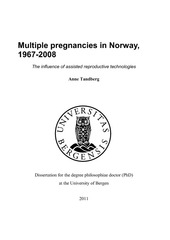Multiple pregnancies in Norway, 1967-2008. The influence of assisted reproductive technologies
Doctoral thesis
Permanent lenke
https://hdl.handle.net/1956/5874Utgivelsesdato
2011-05-05Metadata
Vis full innførselSamlinger
Sammendrag
Background: Multiple pregnancies have increased risk of certain adverse outcomes as preterm birth, low birthweight and higher perinatal mortality rate compared to singleton pregnancies. Data from industrialized countries during the last 20-30 years indicate rising incidences and have therefore been of major concern. The objective of the present thesis was to assess trends, incidence and outcome of multiple pregnancies in Norway during four decades with special focus on maternal age, assisted reproductive technologies (ART) and the mother’s own gestational age and birthweight-bygestational age. Methods: Three population based cohort studies were all based on data from the Medical Birth Registry of Norway. Data were derived from cross-sectional-, sibshipand generational data files provided by linkage of the mothers’ unique identification number and the infants’ day of birth. Outcomes for twins and triplets were compared with those for singletons and estimated for the periods before (1967-1987) and after (1988-2006) information on ART was available in the registry. Contingency tables, stratification, generalized linear models and logistic regressions were used to calculate statistical associations. Results: Incidence: The total twin birth rate in Norway increased from 1.1% in 1967 to 1.9% in 2004. Restricted to spontaneously conceptions, the rate reached 1.6% in 2004. A rise in the total triplet rate was observed from the last part of the eighties and through the nineties, followed by a steep decline from year 2000. The likelihood to conceive with twins increased with the mother’s own birthweight, but was unchanged by her gestational age at birth. Perinatal outcome: The gestational age declined and the cesarean section rate increased in both twin- and triplet pregnancies from the first to the second period. The perinatal mortality rate improved considerably, but was still ten-fold higher in triplets and four times higher in twins compared to singletons in the last period. A proportion of ten percent of the triplets were very preterm born (≤28 weeks), and did partly explain the higher mortality rate for these infants. The mother’s own gestational age and birthweight-by-gestational age had significant impact on the outcome of her reproduction, especially in twin pregnancies. If the mother herself was born at 27-31 weeks, she had four times higher relative risk of losing one or both of her twins compared to term born mothers. Term born mothers with birthweightby- gestational age z-score <-2, also had a high mortality risk in twin offspring. Conclusions: The twin birth rate in Norway has increased nearly 50% during the last decades, even when pregnancies from ART are excluded. The perinatal mortality rates for twins have declined considerably during the same period, but a less favourable improvement is observed for triplets. A twin pregnancy is a high-risk pregnancy if the mother herself is born preterm or is growth restricted at birth. Factors leading to preterm birth or growth restriction in one generation seem to affect reproduction outcome in the next generation, and is clearly revealed in a twin pregnancy.
Består av
Paper 1: Tandberg A, Bjørge T, Børdahl PE, Skjaerven R. Increasing twinning rates in Norway, 1967-2004: The influence of maternal age and assisted reproductive technology (ART). Acta Obstet Gynecol Scand.2007;86(7):833-9. Full text not available in BORA due to publisher restrictions. The published version is available at: http://dx.doi.org/10.1080/00016340701417323Paper 2: Tandberg A, Bjørge T, Nygård O, Børdahl PE, Skjaerven R. Trends in incidence and mortality for triplets in Norway 1967-2006: The influence of assisted reproductive technologies. BJOG 2010;117(6):667-75. Full text not available in BORA due to publisher restrictions. The published version is available at: http://dx.doi.org/10.1111/j.1471-0528.2010.02530.x
Paper 3: Tandberg A, Melve KK, Nordtveit TI, Bjørge T, Skjaerven R. Maternal birth characteristics and perinatal mortality in twin offspring. An intergenerational population-based study in Norway 1967-2008. BJOG 2011;118(6):698-705. Full text not available in BORA due to publisher restrictions. Full text not available in BORA due to publisher restrictions. The published version is available at: http://dx.doi.org/10.1111/j.1471-0528.2010.02877.x
